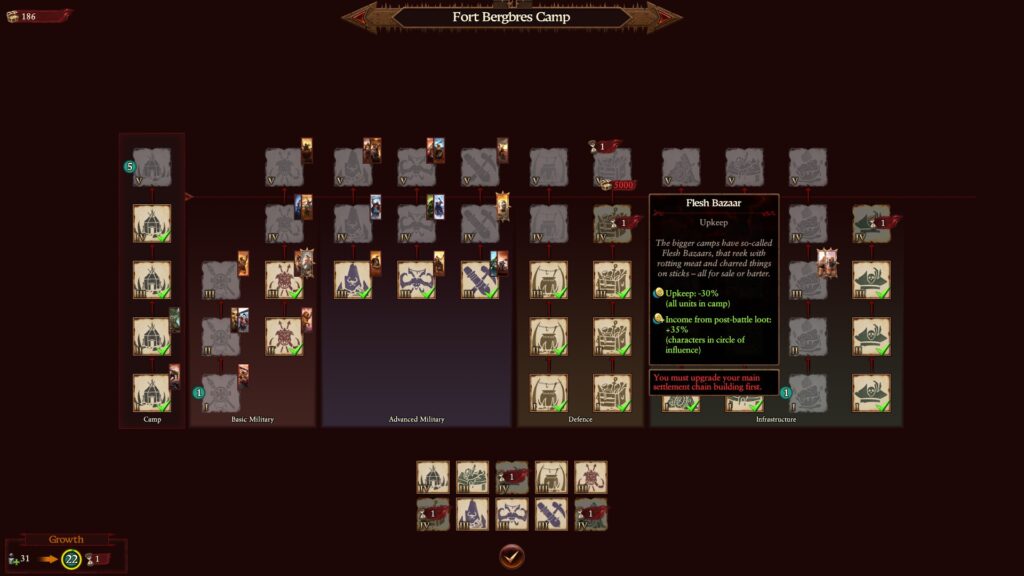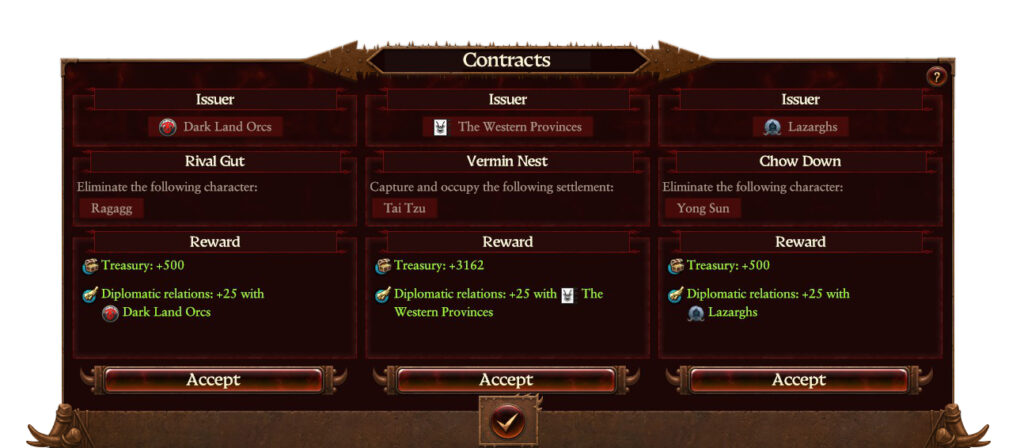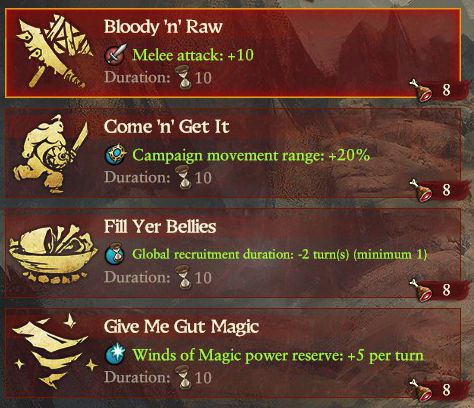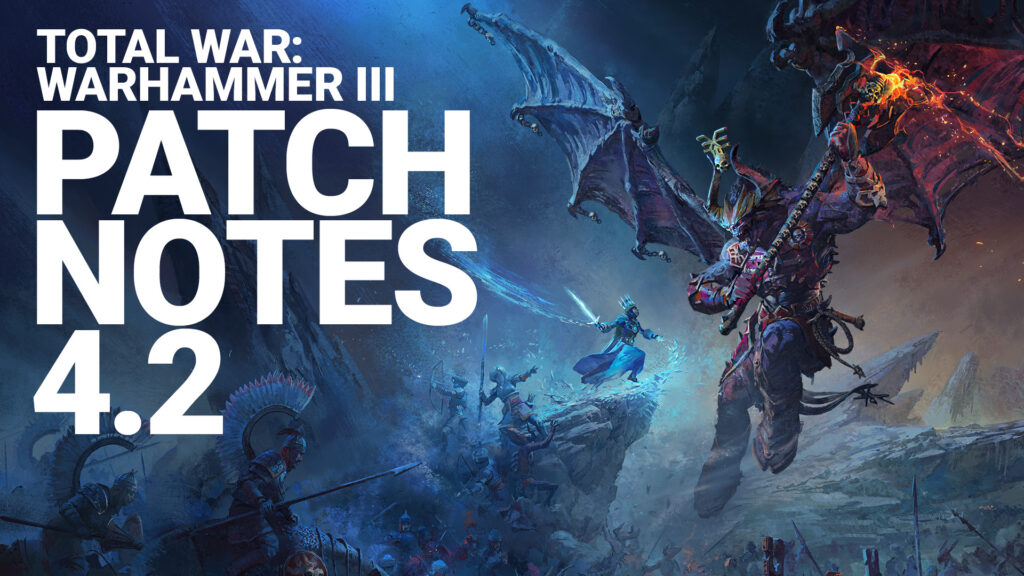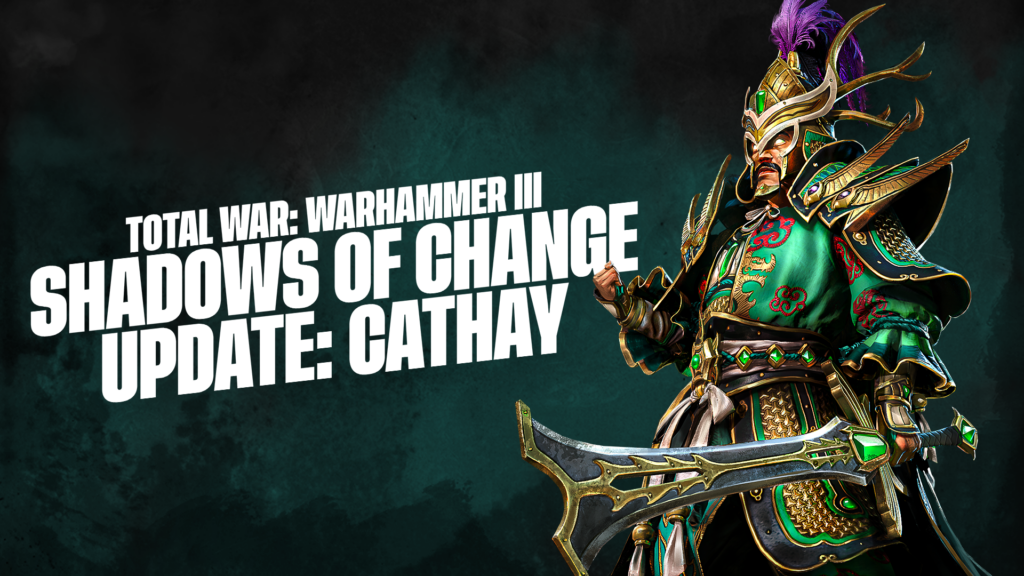
Consume the world with the Ogre Kingdoms campaign mechanics
The world’s biggest eaters, rowdiest Blood Bowl fans, and largest overall nuisances have arrived in Total War: WARHAMMER III. After many months of speculation, your Early Adopter bonus for the game is the Ogre Kingdoms, filling out the central area of the map with the many tribes of maneaters, ironguts, bulls, and many more. They’re a fully-fledged race (and will be present as potential enemies and allies on the campaign map even if you don’t own their DLC from getting the game early enough or buying it separately) with their own legendary lords, units, heroes, goals, dreams, hopes, meals – and campaign mechanics, which brings us to the below.
Greasus Goldtooth and Skrag the Slaughterer have quite different campaigns, and we’ll get into the specifics of them a little further down the road in our Legendary Lord mechanics series. However, what’s laid out below is what they share, the fundamentals of the Ogre race and how they interact, make war, and, most importantly, eat.
Camps
Perhaps the most iconic area of Ogre society is the camp – a great set of buildings (or, often, assorted piles) around a central pot of meat, gristle, beer, and whatever else has been thrown in on this occasion. Ogre Camps can be set up at any sufficient distance from existing settlements and act as major settlements for the faction. Any captured or colonised settlements are minors with four building slots and max rank three.
Camps are limited in number by technology and, as you’ll see below, unlocking your first camp is the initial tech for the race. New buildings require population surplus to create, similar to a horde, and if the garrison is defeated the camp is destroyed.
However, as well as providing access to higher tier units and buildings, there are some massive benefits to camps. They can be deployed in any territory and any distance from your other lands, so long as you can get an army there. Assuming it’s in enemy territory, the garrison inside will automatically be raiding the province it’s in every turn, generating additional income. This garrison can be reinforced by trading units to and from it with an army or recruiting directly into the camp, meaning you can have a properly massive and powerful raiding army that is also well-defended within a pseudo-settlement that must be sieged to be destroyed. It can also provide units to passing armies, giving you a refueling and upgrading station for your forces when they don’t have time to recruit themselves.
Camps also exert a sphere of influence of decent size on the campaign map, and any armies within that area will receive various bonuses, as well as being able to use local recruitment. Various buildings inside the camp will also have effects within this area of influence, letting it provide additional replenishment, extra Meat (see below), or other benefits. Naturally, this makes placement vital to consider – a more defensible location on the edge of your own territory is valuable, but one in the center of enemy provinces is quite a different prospect. The more fighting within range of a camp, the better.
For other factions, Ogre Camps represent a place to bring Ogre talents aboard. Any army that is near an Ogre Camp and is not at war with the owner can hire Ogre Bulls as mercenaries.
Of note is that the non-recruitment buildings in camps also provide some pretty hefty upgrades. Loot Piles give an obnoxious amount of gold per turn while there are options for massively reduced upkeep of the units inside. There are also possibilities for huge increases in local recruitment capacities, global effects, and other profitable ventures. Owning regions is valuable, but multiple large camps will render you a force to be reckoned with.
Contracts
There’s a reason Ogres first entered Total War as mercenaries – it’s what they do best. They’re the largest, toughest, most violent force they’ve ever met (Greenskins really have a problem with this), so why not use their natural talents for profit? Hence, contracts, special missions given to you as an Ogre player by the various AI factions around you.
Every ten turns you will be presented with three potential contracts, each for attacking cities, killing characters, or destroying armies. These will come from factions you are not at war with and offer money for completion. You will also get a significant relationship boost with the hiring faction should you complete their contract.
This is a good excuse to start a war, usually one which will get you a good reputation with someone else nearby. Of course, money talks much louder than loyalty, and there’s nothing stopping you turning on just about everyone once you’ve taken the gold they were willing to give up without a fight.
Meat
As your body may run on water and nutrients and our economy on the blood of the workers, Ogre society runs on meat. Eating and fighting are the central tenets of everything they do, and usually the fighting is to get ready for a big batch of eating, and the eating is so they’re well-fueled for the fighting. The two are often combined in horrific displays of brutality on the battlefield that will send enemies fleeing.
Thus, every Ogre army has a separate upkeep, as well as in gold, of Meat. One unit, one meat consumed. The meat each army has and if it’s increasing or decreasing is tracked above its banner on the campaign map, in the same spot as any passive effects and if it’s garrisoned or not. This upkeep is waived when within range of a friendly Ogre Camp, and as mentioned, there are plenty of camp buildings with interactions surrounding meat. Naturally, enemy armies can also be, ahem, processed into meat, post-defeat.
Far from just a second upkeep bar, meat also has a number of uses. Any time an Ogre army is engaged in battle, it can initiate a pre-battle feast. Up to five meat can be used from its stores, with each piece giving a stacking bonus to speed, charge bonus, and unit mass. Bigger, heavier ogres do bigger, more powerful charges.
In addition, all Ogre armies can initiate Offerings to the Great Maw, giving some of their meat up for bonuses. These are buffs that last for a large number of turns for that army, and are:
- Bloody ‘n’ Raw – extra melee attack for all units.
- Come ‘n’ Get It – additional campaign movement range for the army.
- Fill Yer Bellies – Decrease in global recruitment times.
- Give Me Gut Magic – additional Winds of Magic power reserves per turn.
Only one of these buffs can be active at a time, but they can have permanent uptime assuming there is always spare meat lying around when the offering is available.
Big Names

Ogres can’t read or write and have no interest in the matter. Their campfire stories, once the fighting has died down and only the most obese are still eating, come from personally-told tales, handed from generation to generation or bragged about from the perpetrator. Thus, the concept of Ogre titles, or Big Names, was born. While Settra may claim the most length, Ogres have the largest breadth of names and their possible meanings.
Each and every Ogre Lord has four Big Names he can strive for, each with different unlock conditions. This is as true of our Legendary Lords, Greasus Goldtooth and Skrag the Slaughterer, as it is for the Tyrants and Slaughtermasters that lead your other armies. For the legendary, there is a bespoke choice of four, while the others take a random selection from a wider pool for each Lord type.
Once a Big Name is unlocked, it can be equipped as a primary title, giving a specific effect. The system as a whole is similar to the passive traits that Lords advertise when they are hired, but customisable depending on your plans and usually more powerful. Changing primary titles can be done on a short cooldown, so mix and match as needed.
Here’s four from a random Tyrant, Thrugg Brutbane, I just generated:
- Arsebelcher
- Unlocked by: It is a mystery!
- Grants: Arsebelcher ability, a leadership debuff for all enemies nearby.
- Campmaker
- Unlocked by: deploying a camp with this character.
- Grants: +1 control to local province.
- Boommaker
- Unlocked by: winning a battle with a unit of Leadbelchers in the army.
- Grants: +20% missile strength for various ranged units.
- Kineater
- Unlocked by: losing a battle but killing more enemies than your opponent.
- Grants: Passive ability Kineater, which gives unbreakable to this lord so long as they have over half HP.
As you can see, they aren’t army-defining, but could be used to make a specific lord more his own, as well as giving mini-objectives from turn to turn with each of your armies. The Legendary Lord versions are a step above these in power, supplementing the power of your faction.
Tech Tree

As mentioned, the subtleties of language and thus research, knowledge retention, education and much else that the rest of the world uses to advance society, are mysterious and uninteresting to Ogres.
Instead, their idea of research is mostly theft, coming up with better ways to eat more and charge higher sums for their services, and consuming the brains of their enemies to discover new possibilities. Their tech tree reflects this by being focused on key points that increase the number of camps you have access to, as well as the starting population of those camps, letting you set up new buildings quicker.
It is quite a dense tree (echoing its researchers), taking not a lot of time to go from end to end if you simply focus on progressing, but with lots and lots of possibilities to take a tech here or there that significantly buffs a unit or economic element. Several of the camp-improving techs also unlock powerful army abilities focused on consuming prisoners in battle for fantastic and terrifying effects.
Fill Yer Belly
Those are the Ogres – violent, gluttonous, and a hell of a lot of fun to play. While they are not as automatically warlike as the daemon races (who they are as happy to work and ally with, so long as it pays), the haphazard nature with which they engage in warfare and their easy-going nature comes to the fore easily. Oh, well, if someone’s going to pay – why not take this city or that? Why not crush an army or kill a general? It’s all meat for the belly, after all.
